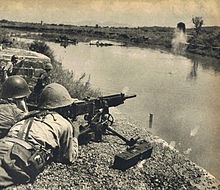Type 92 helmet

The helmet type 92 (in the Japanese original: 九 〇 式 鉄 帽) is a steel helmet that was designed around 1930 and used by the Imperial Japanese Army .
History and background
At the end of the 1920s and the beginning of the 1930s, considerations arose in Japan to develop an independent helmet design for the army. Samples of the British Brodie, the German steel helmet and the French Adrian helmet were examined. The knowledge gained led to the design of the Type 92. On April 28, 1932, the helmet was introduced as an official part of the equipment. The helmet had a leather lining and was made of chrome molybdenum steel. The weight of the helmet was 1 kg. The battle showed that the helmet provided good protection against splinters. On the other hand, he did not adequately withstand direct shots on the helmet. A 7.7-caliber bullet penetrated the helmet itself from a distance of 1000 meters. This led to a revision of the helmet, which resulted in the development of the Type 98 .
literature
- Елена Холодная. Лейтенант Дорофей Левченко // газета "Красная звезда", № 237 (4087) от 14 октября 1938. стр.3